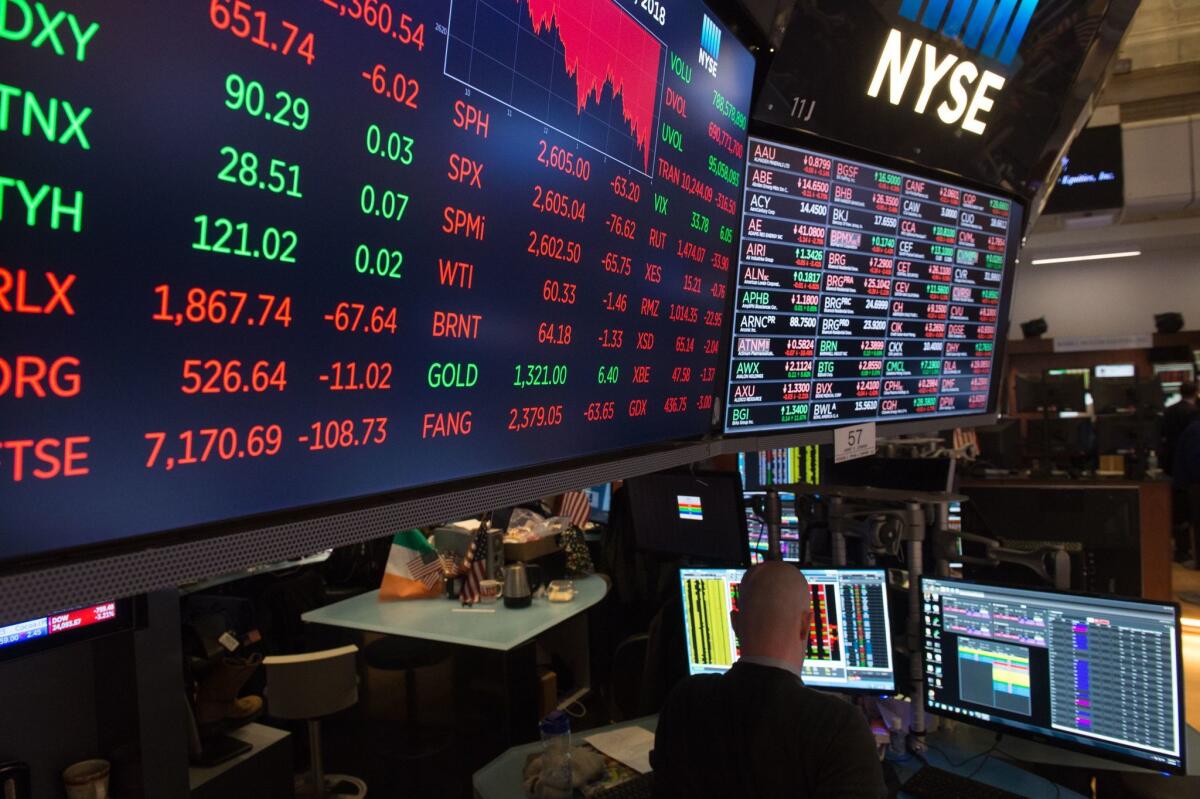How to keep your cool in this stock market sell-off

- Share via
A sell-off in the U.S. stock market that began last week worsened this week, as the major indexes wiped out their year-to-date gains.
What’s to blame? Investors are spooked about signs of faster inflation, which could lead the Federal Reserve to raise interest rates more times this year, thereby raising borrowing costs for companies and consumers.
While Monday’s 1,100-point drop in the Dow Jones industrial average was the biggest in years, followed by another 1,032-drop on Thursday, it’s important to put the recent losses in context. The percentage drops are well below those seen in the 2008 financial crisis and other market crashes.
The U.S. stock market today is essentially at the same level it was a few months ago. That may be of little comfort as the value of your portfolio shrinks, but should the market plummet even more dramatically at some point, this drop will serve as a trial run. And the good news is, the stock market is resilient, so you’ll make it through this sell-off — and future ones — with a little patience.
Staying invested for the long haul is the most prudent approach, especially when it seems you should run for the exits. Here are three ways to cope with those times.
1. Stay calm — this is normal
No pussyfooting around here: Sell-offs are painful. In a matter of days — or hours — your portfolio’s value tumbles, wiping out hard-won gains. They’re also pretty common. Since the start of 2011, the Standard & Poor’s 500 index has experienced six sell-offs ranging from 5% to 10% in magnitude, according to data compiled by Yardeni Research.
Painful as the prospect is, fretting about a market crash can lead you to invest too conservatively, and outright panic could put you at risk of making disastrous, emotional investing decisions. And it’s best to avoid the inevitable debate raised when sell-offs do occur: Is the slump a harbinger of more drastic declines?
You may need to redefine what’s normal. After an unusually steep rise in stock prices in January — in which the S&P 500 rose more than 7% in less than four weeks — many professional investors see the current sell-off as long overdue.
“The straight-up rally we had been experiencing was not normal, nor healthy,” Matt Maley, managing director at capital markets firm Miller Tabak & Co., wrote in a recent note to clients. What is normal and healthy? Declines in the magnitude of 5% to 10%, he said.
2. Stay invested
If the stock market’s latest slump has you feeling sick to your stomach, take a deep breath. These declines feel more severe because it’s been such a long time since the market experienced this type of volatility.
While many investors didn’t tune in every day as stocks inched higher over a prolonged period in 2017, the market’s got their attention now, says Kate Warne, an investment strategist at financial services firm Edward Jones. “The next time stocks are down 10%, emotions will run higher.”
Even so, staying invested is the key to long-term success. And rather than selling, Warne says investors should consider being opportunistic. “We continue to see pullbacks as opportunities,” she says.
Lower stock prices are an underappreciated perk of market sell-offs. If your investment thesis still stands — and you have money to invest — now is a good time to consider adding to existing positions or finding new ones. But prepare for some possible angst: You could buy assets only to watch their prices sink even lower.
In addition, ensuring your portfolio is well-diversified will help you weather a market storm. You can easily broaden your portfolio’s exposure by investing in the following products: exchange-traded funds, mutual funds, bonds and individual stocks. In addition, select investments within those groups across a range of geographies, industries and company sizes.
3. Look for perspective
Even with these declines, U.S. stocks still are in the midst of history’s second-longest bull market, with the S&P 500 more than quadrupling over that stretch.
There have been 12 corrections — losses of at least 10% — since 1980, four of which happened during the current bull market cycle. When losses reach 20%, it’s a bear market. These are less common. There have been only four since 1980, the most recent of which helped usher in the Great Recession at the end of 2007.
Even if that worst-case scenario happens, there’s a silver lining. Bear markets are generally shorter — clocking in at 1.4 years on average, versus nine years for bull markets — and less severe, with average cumulative losses of 41% compared with gains of 480% in bull markets, according to First Trust Advisors.
Need more reassurance? The market has bounced back from worse. Perhaps you’re old enough to remember Oct. 19, 1987 — or “Black Monday” — when the Dow plummeted more than 20%, the worst single-day sell-off in history.
But wait, is the worst over?
It’s anyone’s guess, but people love to do exactly that. Pundits have predicted an end to the current bull market for years — and yet it has endured. Only time will prove whether this sell-off will be the catalyst that finally ends it.
Jackson writes for NerdWallet, a personal finance news website.
Inside the business of entertainment
The Wide Shot brings you news, analysis and insights on everything from streaming wars to production — and what it all means for the future.
You may occasionally receive promotional content from the Los Angeles Times.







